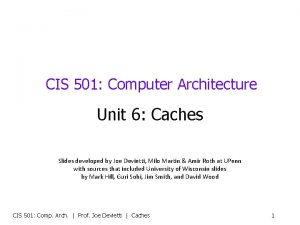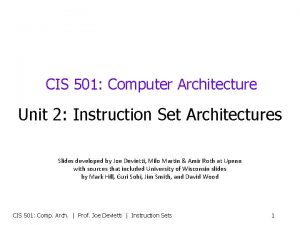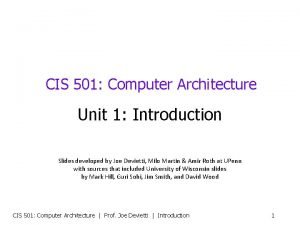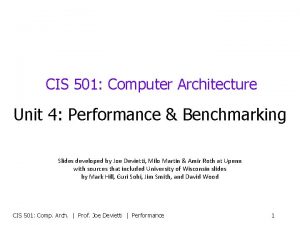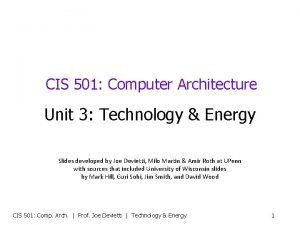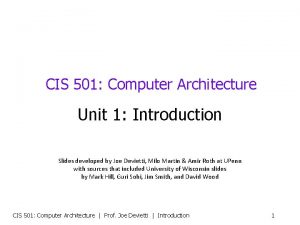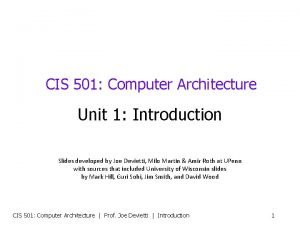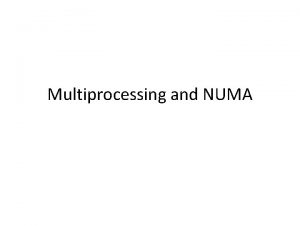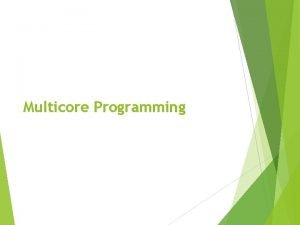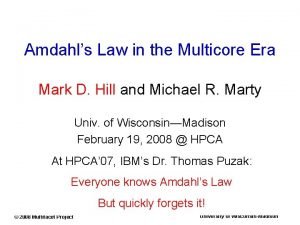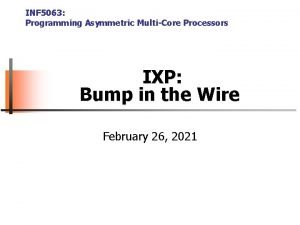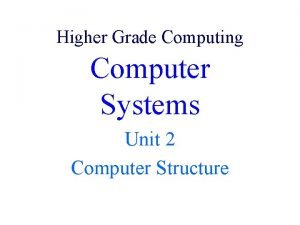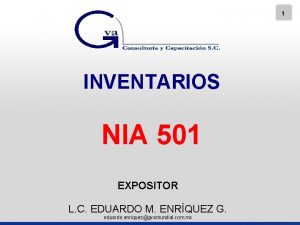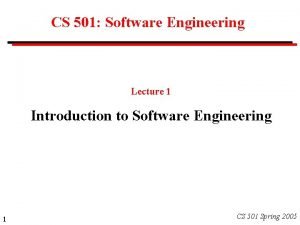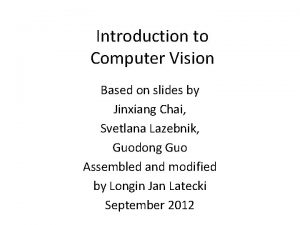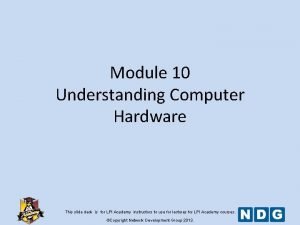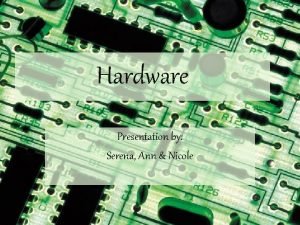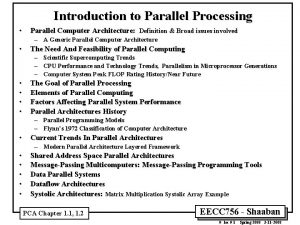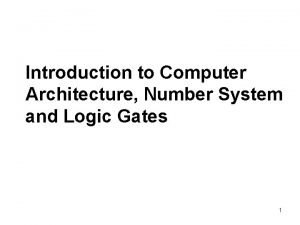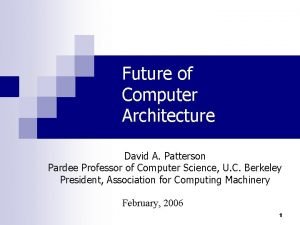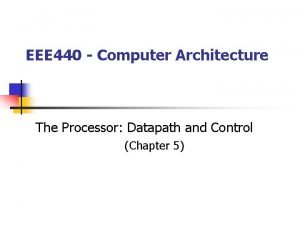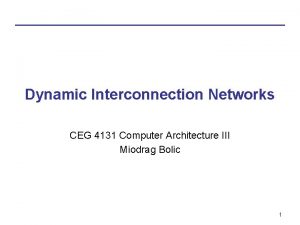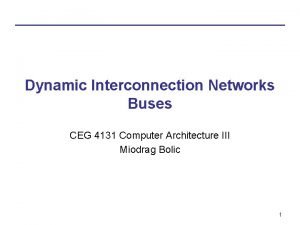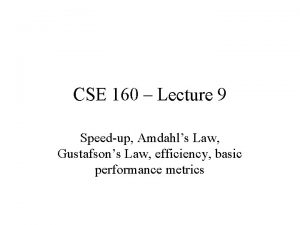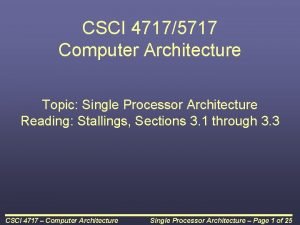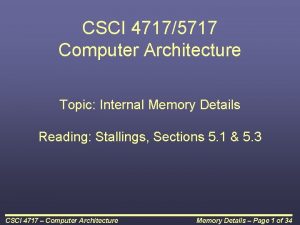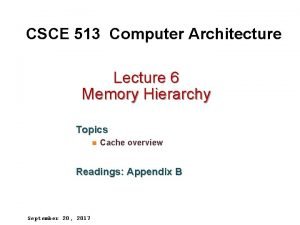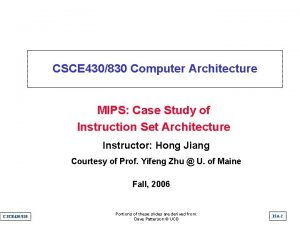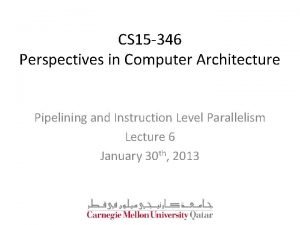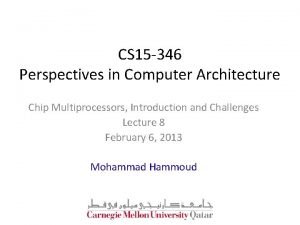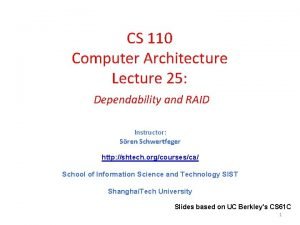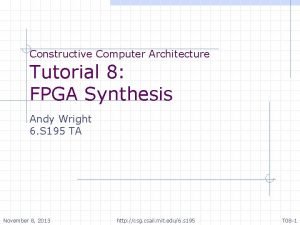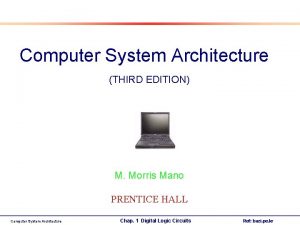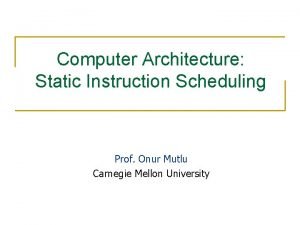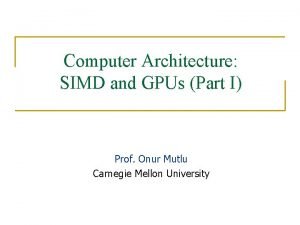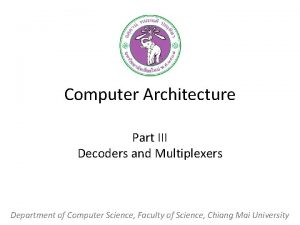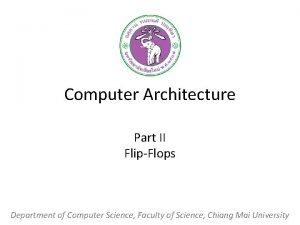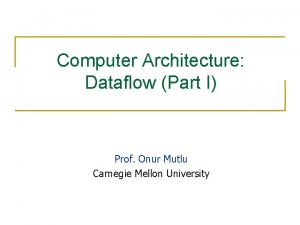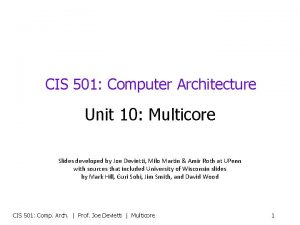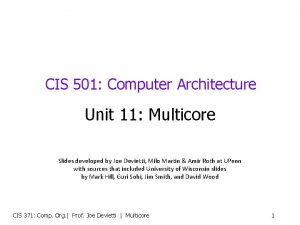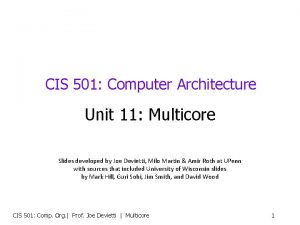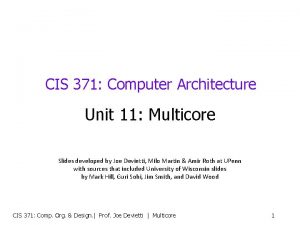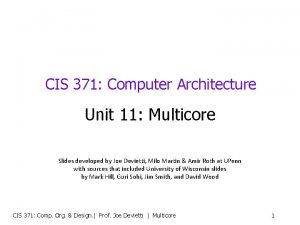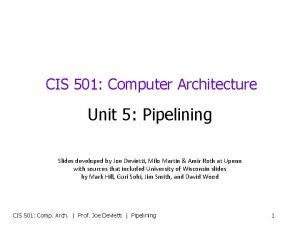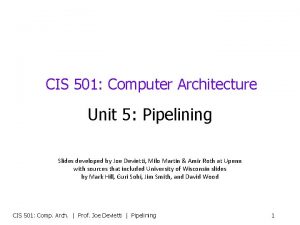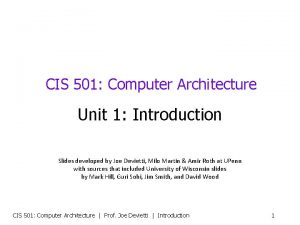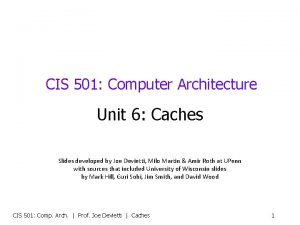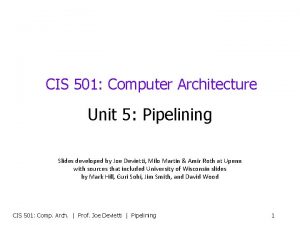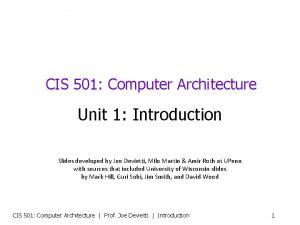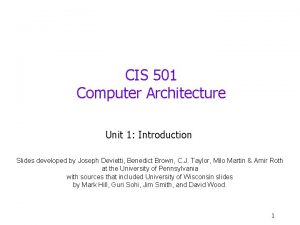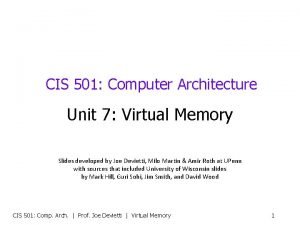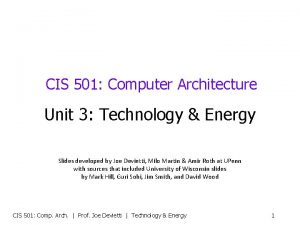CIS 501 Computer Architecture Unit 10 Multicore Slides



![Beyond Implicit Parallelism • Consider “daxpy”: double a, x[SIZE], y[SIZE], z[SIZE]; void daxpy(): for Beyond Implicit Parallelism • Consider “daxpy”: double a, x[SIZE], y[SIZE], z[SIZE]; void daxpy(): for](https://slidetodoc.com/presentation_image_h2/d1d1d38946f3213650c4c0ec5dc2b2e6/image-4.jpg)
![Explicit Parallelism • Consider “daxpy”: double a, x[SIZE], y[SIZE], z[SIZE]; void daxpy(): for (i Explicit Parallelism • Consider “daxpy”: double a, x[SIZE], y[SIZE], z[SIZE]; void daxpy(): for (i](https://slidetodoc.com/presentation_image_h2/d1d1d38946f3213650c4c0ec5dc2b2e6/image-5.jpg)
![Explicit Parallelism • Consider “daxpy”: double a, x[SIZE], y[SIZE], z[SIZE]; void daxpy(int chunk_id): chuck_size Explicit Parallelism • Consider “daxpy”: double a, x[SIZE], y[SIZE], z[SIZE]; void daxpy(int chunk_id): chuck_size](https://slidetodoc.com/presentation_image_h2/d1d1d38946f3213650c4c0ec5dc2b2e6/image-6.jpg)























![Shared Cache Implementation P 0 P 1 P 2 Load [A] 1 Interconnect Shared Shared Cache Implementation P 0 P 1 P 2 Load [A] 1 Interconnect Shared](https://slidetodoc.com/presentation_image_h2/d1d1d38946f3213650c4c0ec5dc2b2e6/image-30.jpg)
![Shared Cache Implementation P 0 P 1 P 2 Load [A] (500) 1 4 Shared Cache Implementation P 0 P 1 P 2 Load [A] (500) 1 4](https://slidetodoc.com/presentation_image_h2/d1d1d38946f3213650c4c0ec5dc2b2e6/image-31.jpg)
![Shared Cache Implementation P 0 P 1 P 2 Store 400 -> [A] 1 Shared Cache Implementation P 0 P 1 P 2 Store 400 -> [A] 1](https://slidetodoc.com/presentation_image_h2/d1d1d38946f3213650c4c0ec5dc2b2e6/image-32.jpg)
![Shared Cache Implementation P 0 P 1 P 2 Store 400 -> [A] 1 Shared Cache Implementation P 0 P 1 P 2 Store 400 -> [A] 1](https://slidetodoc.com/presentation_image_h2/d1d1d38946f3213650c4c0ec5dc2b2e6/image-33.jpg)






![Private Cache Problem: Incoherence P 0 1 C 1 P 1 Load [A] Cache Private Cache Problem: Incoherence P 0 1 C 1 P 1 Load [A] Cache](https://slidetodoc.com/presentation_image_h2/d1d1d38946f3213650c4c0ec5dc2b2e6/image-40.jpg)
![Private Cache Problem: Incoherence P 0 1 P 1 Load [A] (500) Cache Tag Private Cache Problem: Incoherence P 0 1 P 1 Load [A] (500) Cache Tag](https://slidetodoc.com/presentation_image_h2/d1d1d38946f3213650c4c0ec5dc2b2e6/image-41.jpg)
![Private Cache Problem: Incoherence P 0 1 Load [A] (500) Cache Tag Data A Private Cache Problem: Incoherence P 0 1 Load [A] (500) Cache Tag Data A](https://slidetodoc.com/presentation_image_h2/d1d1d38946f3213650c4c0ec5dc2b2e6/image-42.jpg)

![Use Tracking Information to “Invalidate” P 0 1 Load [A] Cache Tag Data State Use Tracking Information to “Invalidate” P 0 1 Load [A] Cache Tag Data State](https://slidetodoc.com/presentation_image_h2/d1d1d38946f3213650c4c0ec5dc2b2e6/image-44.jpg)
![Use Tracking Information to “Invalidate” P 0 1 Load [A] Cache Tag Data State Use Tracking Information to “Invalidate” P 0 1 Load [A] Cache Tag Data State](https://slidetodoc.com/presentation_image_h2/d1d1d38946f3213650c4c0ec5dc2b2e6/image-45.jpg)
![Use Tracking Information to “Invalidate” P 0 1 Load [A] (400) Cache Tag Data Use Tracking Information to “Invalidate” P 0 1 Load [A] (400) Cache Tag Data](https://slidetodoc.com/presentation_image_h2/d1d1d38946f3213650c4c0ec5dc2b2e6/image-46.jpg)
![Use Tracking Information to “Invalidate” P 0 1 Load [A] (400) Cache Tag Data Use Tracking Information to “Invalidate” P 0 1 Load [A] (400) Cache Tag Data](https://slidetodoc.com/presentation_image_h2/d1d1d38946f3213650c4c0ec5dc2b2e6/image-47.jpg)


![MSI Coherence Example: Step #1 P 0 Load [A] Cache Tag Data State ---- MSI Coherence Example: Step #1 P 0 Load [A] Cache Tag Data State ----](https://slidetodoc.com/presentation_image_h2/d1d1d38946f3213650c4c0ec5dc2b2e6/image-50.jpg)
![MSI Coherence Example: Step #2 P 0 Load [A] Cache Tag Data State ------- MSI Coherence Example: Step #2 P 0 Load [A] Cache Tag Data State -------](https://slidetodoc.com/presentation_image_h2/d1d1d38946f3213650c4c0ec5dc2b2e6/image-51.jpg)
![MSI Coherence Example: Step #3 P 0 Load [A] Cache Tag Data State ------- MSI Coherence Example: Step #3 P 0 Load [A] Cache Tag Data State -------](https://slidetodoc.com/presentation_image_h2/d1d1d38946f3213650c4c0ec5dc2b2e6/image-52.jpg)
![MSI Coherence Example: Step #4 P 0 Load [A] Cache Tag Data State A MSI Coherence Example: Step #4 P 0 Load [A] Cache Tag Data State A](https://slidetodoc.com/presentation_image_h2/d1d1d38946f3213650c4c0ec5dc2b2e6/image-53.jpg)
![MSI Coherence Example: Step #5 P 0 Load [A] (400) Cache Tag Data State MSI Coherence Example: Step #5 P 0 Load [A] (400) Cache Tag Data State](https://slidetodoc.com/presentation_image_h2/d1d1d38946f3213650c4c0ec5dc2b2e6/image-54.jpg)
![MSI Coherence Example: Step #6 P 0 Store 300 -> [A] Cache Tag Data MSI Coherence Example: Step #6 P 0 Store 300 -> [A] Cache Tag Data](https://slidetodoc.com/presentation_image_h2/d1d1d38946f3213650c4c0ec5dc2b2e6/image-55.jpg)
![MSI Coherence Example: Step #7 P 0 Store 300 -> [A] Cache Tag Data MSI Coherence Example: Step #7 P 0 Store 300 -> [A] Cache Tag Data](https://slidetodoc.com/presentation_image_h2/d1d1d38946f3213650c4c0ec5dc2b2e6/image-56.jpg)
![MSI Coherence Example: Step #8 P 0 Store 300 -> [A] Cache Tag Data MSI Coherence Example: Step #8 P 0 Store 300 -> [A] Cache Tag Data](https://slidetodoc.com/presentation_image_h2/d1d1d38946f3213650c4c0ec5dc2b2e6/image-57.jpg)
![MSI Coherence Example: Step #9 P 0 Store 300 -> [A] Cache Tag Data MSI Coherence Example: Step #9 P 0 Store 300 -> [A] Cache Tag Data](https://slidetodoc.com/presentation_image_h2/d1d1d38946f3213650c4c0ec5dc2b2e6/image-58.jpg)
![MSI Coherence Example: Step #10 P 0 Store 300 -> [A] Cache Tag Data MSI Coherence Example: Step #10 P 0 Store 300 -> [A] Cache Tag Data](https://slidetodoc.com/presentation_image_h2/d1d1d38946f3213650c4c0ec5dc2b2e6/image-59.jpg)
![MSI Coherence Example: Step #11 P 0 Store 300 -> [A] Cache Tag Data MSI Coherence Example: Step #11 P 0 Store 300 -> [A] Cache Tag Data](https://slidetodoc.com/presentation_image_h2/d1d1d38946f3213650c4c0ec5dc2b2e6/image-60.jpg)















































![Speculative Lock Elision (SLE) Processor 0 acquire(accts[37]. lock); // don’t actually set lock to Speculative Lock Elision (SLE) Processor 0 acquire(accts[37]. lock); // don’t actually set lock to](https://slidetodoc.com/presentation_image_h2/d1d1d38946f3213650c4c0ec5dc2b2e6/image-108.jpg)















- Slides: 123

CIS 501: Computer Architecture Unit 10: Multicore Slides developed by Joe Devietti, Milo Martin & Amir Roth at UPenn with sources that included University of Wisconsin slides by Mark Hill, Guri Sohi, Jim Smith, and David Wood CIS 501: Comp. Arch. | Prof. Joe Devietti | Multicore 1

This Unit: Shared Memory Multiprocessors App App System software Mem CPU CPU CPU I/O • Thread-level parallelism (TLP) • Shared memory model • Multiplexed uniprocessor • Hardware multithreading • Multiprocessing • Cache coherence • Valid/Invalid, MSI, MESI • Parallel programming • Synchronization • Lock implementation • Locking gotchas • Transactional memory • Memory consistency models CIS 501: Comp. Arch. | Prof. Joe Devietti | Multicore 2

Readings • Textbook (MA: FSPTCM) • Sections 7. 0, 7. 1. 3, 7. 2 -7. 4 • Section 8. 2 • “Suggested” reading • “A Primer on Memory Consistency and Cache Coherence” (Synthesis Lectures on Computer Architecture) by Daniel Sorin, Mark Hill, and David Wood, November 2011 • “Why On-Chip Cache Coherence is Here to Stay” by Milo Martin, Mark Hill, and Daniel Sorin, Communications of the ACM (CACM), July 2012. • “Speculative Lock Elision: Enabling Highly Concurrent Multithreaded Execution” by Rajwar & Goodman, MICRO 2001 CIS 501: Comp. Arch. | Prof. Joe Devietti | Multicore 3
![Beyond Implicit Parallelism Consider daxpy double a xSIZE ySIZE zSIZE void daxpy for Beyond Implicit Parallelism • Consider “daxpy”: double a, x[SIZE], y[SIZE], z[SIZE]; void daxpy(): for](https://slidetodoc.com/presentation_image_h2/d1d1d38946f3213650c4c0ec5dc2b2e6/image-4.jpg)
Beyond Implicit Parallelism • Consider “daxpy”: double a, x[SIZE], y[SIZE], z[SIZE]; void daxpy(): for (i = 0; i < SIZE; i++) z[i] = a*x[i] + y[i]; • Lots of instruction-level parallelism (ILP) • Great! • But how much can we really exploit? 4 wide? 8 wide? • Limits to (efficient) super-scalar execution • But, if SIZE is 10, 000 the loop has 10, 000 -way parallelism! • How do we exploit it? CIS 501: Comp. Arch. | Prof. Joe Devietti | Multicore 4
![Explicit Parallelism Consider daxpy double a xSIZE ySIZE zSIZE void daxpy for i Explicit Parallelism • Consider “daxpy”: double a, x[SIZE], y[SIZE], z[SIZE]; void daxpy(): for (i](https://slidetodoc.com/presentation_image_h2/d1d1d38946f3213650c4c0ec5dc2b2e6/image-5.jpg)
Explicit Parallelism • Consider “daxpy”: double a, x[SIZE], y[SIZE], z[SIZE]; void daxpy(): for (i = 0; i < SIZE; i++) z[i] = a*x[i] + y[i]; • Break it up into N “chunks” on N cores! • Done by the programmer (or maybe a really smart compiler) void daxpy(int chunk_id): chuck_size = SIZE / N my_start = chuck_id * chuck_size my_end = my_start + chuck_size for (i = my_start; i < my_end; i++) z[i] = a*x[i] + y[i] • Assumes SIZE = 400, N=4 Chunk ID Start End 0 1 2 3 0 100 200 300 99 199 299 399 • Local variables are “private” and x, y, and z are “shared” • Assumes SIZE is a multiple of N (that is, SIZE % N == 0) CIS 501: Comp. Arch. | Prof. Joe Devietti | Multicore 5
![Explicit Parallelism Consider daxpy double a xSIZE ySIZE zSIZE void daxpyint chunkid chucksize Explicit Parallelism • Consider “daxpy”: double a, x[SIZE], y[SIZE], z[SIZE]; void daxpy(int chunk_id): chuck_size](https://slidetodoc.com/presentation_image_h2/d1d1d38946f3213650c4c0ec5dc2b2e6/image-6.jpg)
Explicit Parallelism • Consider “daxpy”: double a, x[SIZE], y[SIZE], z[SIZE]; void daxpy(int chunk_id): chuck_size = SIZE / N my_start = chuck_id * chuck_size my_end = my_start + chuck_size for (i = my_start; i < my_end; i++) z[i] = a*x[i] + y[i] • Main code then looks like: parallel_daxpy(): for (tid = 0; tid < CORES; tid++) { spawn_task(daxpy, tid); } wait_for_tasks(CORES); CIS 501: Comp. Arch. | Prof. Joe Devietti | Multicore 6

Explicit (Loop-Level) Parallelism • Another way: “Open. MP” annotations to inform the compiler double a, x[SIZE], y[SIZE], z[SIZE]; void daxpy() { #pragma omp parallel for (i = 0; i < SIZE; i++) { z[i] = a*x[i] + y[i]; } • Look familiar? • Hint: homework #1 • But only works if loop is actually parallel • If not parallel, unpredictable incorrect behavior may result CIS 501: Comp. Arch. | Prof. Joe Devietti | Multicore 7

MULTICORE & MULTIPROCESSOR HARDWARE CIS 501: Comp. Arch. | Prof. Joe Devietti | Multicore 8

Multiplying Performance • A single core can only be so fast • Limited clock frequency • Limited instruction-level parallelism • What if we need even more computing power? • Use multiple cores! But how? • Old-school (2000 s): Ultra Enterprise 25 k • • 72 dual-core Ultra. SPARC IV+ processors Up to 1 TB of memory Niche: large database servers $$$, weights more than 1 ton • Today: multicore is everywhere • Can’t buy a single-core smartphone CIS 501: Comp. Arch. | Prof. Joe Devietti | Multicore 9

Intel Quad-Core “Core i 7” CIS 501: Comp. Arch. | Prof. Joe Devietti | Multicore 10

Multicore: Mainstream Multiprocessors • Multicore chips • IBM Power 5 Core 1 • Two 2+GHz Power. PC cores • Shared 1. 5 MB L 2, L 3 tags Core 2 • AMD Quad Phenom • Four 2+ GHz cores • Per-core 512 KB L 2 cache • Shared 2 MB L 3 cache 1. 5 MB L 2 • Intel Core i 7 Quad L 3 tags • Four cores, private L 2 s • Shared 8 MB L 3 • Sun Niagara Why multicore? What else would you do with 1 billion transistors? CIS 501: Comp. Arch. | Prof. Joe Devietti | Multicore • 8 cores, each 4 -way threaded • Shared 2 MB L 2 • For servers, not desktop 11

Sun Niagara II CIS 501: Comp. Arch. | Prof. Joe Devietti | Multicore 12

Application Domains for Multiprocessors • Scientific computing/supercomputing • Examples: weather simulation, aerodynamics, protein folding • Large grids, integrating changes over time • Each processor computes for a part of the grid • Server workloads • Example: airline reservation database • Many concurrent updates, searches, lookups, queries • Processors handle different requests • Media workloads • Processors compress/decompress different parts of image/frames • Desktop workloads… • Gaming workloads… But software must be written to expose parallelism CIS 501: Comp. Arch. | Prof. Joe Devietti | Multicore 13

Recall: Multicore & Energy • Explicit parallelism (multicore) is highly energy efficient • Recall: dynamic voltage and frequency scaling • Performance vs power is NOT linear • Example: Intel’s Xscale • 1 GHz 200 MHz reduces energy used by 30 x • Consider the impact of parallel execution • What if we used 5 Xscales at 200 Mhz? • Similar performance as a 1 Ghz Xscale, but 1/6 th the energy • 5 cores * 1/30 th = 1/6 th • And, amortizes background “uncore” energy among cores • Assumes parallel speedup (a difficult task) • Subject to Ahmdal’s law CIS 501: Comp. Arch. | Prof. Joe Devietti | Multicore 14

Amdahl’s Law • Restatement of the law of diminishing returns • Total speedup limited by non-accelerated piece • Analogy: drive to work & park car, walk to building • Consider a task with a “parallel” and “serial” portion • What is the speedup with N cores? • Speedup(n, p, s) = (s+p) / (s + (p/n)) • p is “parallel percentage”, s is “serial percentage” • What about infinite cores? • Speedup(p, s) = (s+p) / s = 1 / s • Example: can optimize 50% of program A • Even a “magic” optimization that makes this 50% disappear… • …only yields a 2 X speedup CIS 501: Comp. Arch. | Prof. Joe Devietti | Multicore 15

Amdahl’s Law Graph CIS 501: Comp. Arch. | Prof. Joe Devietti | Multicore Source: Wikipedia 16

“THREADING” & THE SHARED MEMORY EXECUTION MODEL CIS 501: Comp. Arch. | Prof. Joe Devietti | Multicore 17

First, Uniprocessor Concurrency • Software “thread”: Independent flows of execution • “Per-thread” state • Context state: PC, registers • Stack (per-thread local variables) • “Shared” state: globals, heap, etc. • Threads generally share the same memory space • A process is like a thread, but with its own memory space • Java has thread support built in, C/C++ use a thread library • Generally, system software (the O. S. ) manages threads • “Thread scheduling”, “context switching” • In single-core system, all threads share one processor • Hardware timer interrupt occasionally triggers O. S. • Quickly swapping threads gives illusion of concurrent execution • Much more in an operating systems course CIS 501: Comp. Arch. | Prof. Joe Devietti | Multicore 18

Multithreaded Programming Model • Programmer explicitly creates multiple threads • All loads & stores to a single shared memory space • Each thread has its own stack frame for local variables • All memory shared, accessible by all threads • A “thread switch” can occur at any time • Pre-emptive multithreading by OS • Common uses: • Handling user interaction (GUI programming) • Handling I/O latency (send network message, wait for response) • Expressing parallel work via Thread-Level Parallelism (TLP) • This is our focus! CIS 501: Comp. Arch. | Prof. Joe Devietti | Multicore 19

Shared Memory Model: Interleaving • Initially: all variables zero (that is, x=0, y=0) thread 1 thread 2 store 1 → y store 1 → x load y • What value pairs can be read by the two loads? store 1 → y load x store 1 → x load y (x=0, y=1) store 1 → y store 1 → x load y (x=1, y=1) store 1 → y store 1 → x load y load x (x=1, y=1) store 1 → x load y store 1 → y load x (x=1, y=0) store 1 → x store 1 → y load x (x=1, y=1) store 1 → x store 1 → y load x load y (x=1, y=1) • What about (x=0, y=0)? CIS 501: Comp. Arch. | Prof. Joe Devietti | Multicore 20

Shared Memory Implementations • Multiplexed uniprocessor • Runtime system and/or OS occasionally pre-empt & swap threads • Interleaved, but no parallelism • Multiprocessors • Multiply execution resources, higher peak performance • Same interleaved shared-memory model • Foreshadowing: allow private caches, further disentangle cores • Hardware multithreading • Tolerate pipeline latencies, higher efficiency • Same interleaved shared-memory model • All support the shared memory programming model CIS 501: Comp. Arch. | Prof. Joe Devietti | Multicore 21

Simplest Multiprocessor PC Regfile I$ D$ PC Regfile • Replicate entire processor pipeline! • Instead of replicating just register file & PC • Exception: share the caches (we’ll address this bottleneck soon) • Multiple threads execute • Shared memory programming model • Operations (loads and stores) are interleaved “at random” • Loads returns the value written by most recent store to location CIS 501: Comp. Arch. | Prof. Joe Devietti | Multicore 22

Hardware Multithreading PC I$ PC Regfile 0 D$ Regfile 1 THR • Hardware Multithreading (MT) • • • + Multiple threads dynamically share a single pipeline Replicate only per-thread structures: program counter & registers Hardware interleaves instructions Multithreading improves utilization and throughput • Single programs utilize <50% of pipeline (branch, cache miss) • Multithreading does not improve single-thread performance • Individual threads run as fast or even slower • Coarse-grain MT: switch on cache misses Why? • Simultaneous MT: no explicit switching, fine-grain interleaving CIS 501: Comp. Arch. | Prof. Joe Devietti | Multicore 23

Four Shared Memory Issues 1. Cache coherence • If cores have private (non-shared) caches • How to make writes to one cache “show up” in others? 1. Parallel programming • How does the programmer express the parallelism? 2. Synchronization • How to regulate access to shared data? • How to implement “locks”? 3. Memory consistency models • How to keep programmer sane while letting hardware optimize? • How to reconcile shared memory with compiler optimizations, store buffers, and out-of-order execution? CIS 501: Comp. Arch. | Prof. Joe Devietti | Multicore 24

Roadmap Checkpoint App App System software Mem CPU CPU CPU I/O • Thread-level parallelism (TLP) • Shared memory model • Multiplexed uniprocessor • Hardware multihreading • Multiprocessing • Cache coherence • Valid/Invalid, MSI, MESI • Parallel programming • Synchronization • Lock implementation • Locking gotchas • Transactional memory • Memory consistency models CIS 501: Comp. Arch. | Prof. Joe Devietti | Multicore 25

Recall: Simplest Multiprocessor PC Regfile PC Insn Mem Data Mem Regfile • What if we don’t want to share the L 1 caches? • Bandwidth and latency issue • Solution: use per-processor (“private”) caches • Coordinate them with a Cache Coherence Protocol • Must still provide shared-memory invariant: • “Loads read the value written by the most recent store” CIS 501: Comp. Arch. | Prof. Joe Devietti | Multicore 26

No-Cache (Conceptual) Implementation P 0 P 1 P 2 Memory 27

No-Cache (Conceptual) Implementation P 0 P 1 P 2 Interconnect • No caches • Not a realistic design Memory A B 500 0 28

Shared Cache Implementation P 0 P 1 P 2 Interconnect Shared Tag Data Cache Memory A B 500 0 • On-chip shared cache • Lacks per-core caches • Shared cache becomes bottleneck 29
![Shared Cache Implementation P 0 P 1 P 2 Load A 1 Interconnect Shared Shared Cache Implementation P 0 P 1 P 2 Load [A] 1 Interconnect Shared](https://slidetodoc.com/presentation_image_h2/d1d1d38946f3213650c4c0ec5dc2b2e6/image-30.jpg)
Shared Cache Implementation P 0 P 1 P 2 Load [A] 1 Interconnect Shared Tag Data Cache 2 Memory A B 500 0 30
![Shared Cache Implementation P 0 P 1 P 2 Load A 500 1 4 Shared Cache Implementation P 0 P 1 P 2 Load [A] (500) 1 4](https://slidetodoc.com/presentation_image_h2/d1d1d38946f3213650c4c0ec5dc2b2e6/image-31.jpg)
Shared Cache Implementation P 0 P 1 P 2 Load [A] (500) 1 4 Interconnect Shared Tag Data Cache A 500 3 2 Memory A B 500 0 31
![Shared Cache Implementation P 0 P 1 P 2 Store 400 A 1 Shared Cache Implementation P 0 P 1 P 2 Store 400 -> [A] 1](https://slidetodoc.com/presentation_image_h2/d1d1d38946f3213650c4c0ec5dc2b2e6/image-32.jpg)
Shared Cache Implementation P 0 P 1 P 2 Store 400 -> [A] 1 Interconnect Shared Tag Data Cache A 400 Memory A B 500 0 • Write into cache 32
![Shared Cache Implementation P 0 P 1 P 2 Store 400 A 1 Shared Cache Implementation P 0 P 1 P 2 Store 400 -> [A] 1](https://slidetodoc.com/presentation_image_h2/d1d1d38946f3213650c4c0ec5dc2b2e6/image-33.jpg)
Shared Cache Implementation P 0 P 1 P 2 Store 400 -> [A] 1 Interconnect Shared Tag Data Cache A 400 Memory A B 500 0 State Dirty 2 • Mark as “dirty” • Memory not updated 33

Adding Private Caches P 0 P 1 Cache Tag Data P 2 Cache Tag Data Interconnect • Add per-core caches (write-back caches) Shared Tag Data Cache • Reduces latency • Increases throughput • Decreases energy Memory A B State 34

Adding Private Caches P 0 P 1 1 Cache Tag Data P 2 Load [A] Cache Tag Data Interconnect 2 Shared Tag Data Cache State 3 Memory A B 500 35

Adding Private Caches P 0 P 1 1 Cache Tag Data P 2 Load [A] (500) Cache Tag Data A 500 6 Cache Tag Data Interconnect 5 2 Shared Tag Data Cache A 500 4 3 Memory State Clean A B 500 36

Adding Private Caches P 0 P 1 1 Cache Tag Data P 2 Store 400 -> [A] Cache Tag Data A 400 Cache Tag Data Interconnect Shared Tag Data Cache A 500 Memory A B State Clean 500 37

Adding Private Caches P 0 P 1 1 Cache Tag Data P 2 Store 400 -> [A] Cache Tag Data State A 400 Dirty 2 Cache Tag Data Interconnect Shared Tag Data Cache A 500 Memory A B State Clean 500 38

Private Cache Problem: Incoherence P 0 Cache Tag Data P 1 P 2 Cache Tag Data State A 400 Dirty Cache Tag Data Interconnect • What happens Shared Tag Data Cache A 500 when another core tries to read A? Memory A B State Clean 500 39
![Private Cache Problem Incoherence P 0 1 C 1 P 1 Load A Cache Private Cache Problem: Incoherence P 0 1 C 1 P 1 Load [A] Cache](https://slidetodoc.com/presentation_image_h2/d1d1d38946f3213650c4c0ec5dc2b2e6/image-40.jpg)
Private Cache Problem: Incoherence P 0 1 C 1 P 1 Load [A] Cache Tag Data P 2 Cache Tag Data State A 400 Dirty Cache Tag Data Interconnect 2 Shared Tag Data Cache A 500 Memory A B State Clean 500 40
![Private Cache Problem Incoherence P 0 1 P 1 Load A 500 Cache Tag Private Cache Problem: Incoherence P 0 1 P 1 Load [A] (500) Cache Tag](https://slidetodoc.com/presentation_image_h2/d1d1d38946f3213650c4c0ec5dc2b2e6/image-41.jpg)
Private Cache Problem: Incoherence P 0 1 P 1 Load [A] (500) Cache Tag Data A 500 4 P 2 Cache Tag Data State A 400 Dirty Cache Tag Data 3 Interconnect 2 Shared Tag Data Cache A 500 Memory A B State Clean 500 41
![Private Cache Problem Incoherence P 0 1 Load A 500 Cache Tag Data A Private Cache Problem: Incoherence P 0 1 Load [A] (500) Cache Tag Data A](https://slidetodoc.com/presentation_image_h2/d1d1d38946f3213650c4c0ec5dc2b2e6/image-42.jpg)
Private Cache Problem: Incoherence P 0 1 Load [A] (500) Cache Tag Data A 500 P 1 Uh, Oh 4 P 2 Cache Tag Data State A 400 Dirty Cache Tag Data 3 Interconnect 2 • P 0 got the wrong value! Shared Tag Data Cache A 500 Memory A B State Clean 500 42

Rewind: Fix Problem by Tracking Sharers P 0 P 1 P 2 Cache Tag Data State A 400 Dirty Cache Tag Data State Interconnect Shared Tag Data Cache A 500 Memory A B 500 State -- Owner P 1 • Solution: Track copies of each block 43
![Use Tracking Information to Invalidate P 0 1 Load A Cache Tag Data State Use Tracking Information to “Invalidate” P 0 1 Load [A] Cache Tag Data State](https://slidetodoc.com/presentation_image_h2/d1d1d38946f3213650c4c0ec5dc2b2e6/image-44.jpg)
Use Tracking Information to “Invalidate” P 0 1 Load [A] Cache Tag Data State P 1 P 2 Cache Tag Data State A 400 Dirty Cache Tag Data State Interconnect 2 Shared Tag Data Cache A 500 Memory A B State -- Owner P 1 500 44
![Use Tracking Information to Invalidate P 0 1 Load A Cache Tag Data State Use Tracking Information to “Invalidate” P 0 1 Load [A] Cache Tag Data State](https://slidetodoc.com/presentation_image_h2/d1d1d38946f3213650c4c0ec5dc2b2e6/image-45.jpg)
Use Tracking Information to “Invalidate” P 0 1 Load [A] Cache Tag Data State P 1 P 2 Cache Tag Data State A 400 Dirty Cache Tag Data State Interconnect 2 Shared Tag Data Cache A 500 Memory A B State -- 3 Owner P 1 500 45
![Use Tracking Information to Invalidate P 0 1 Load A 400 Cache Tag Data Use Tracking Information to “Invalidate” P 0 1 Load [A] (400) Cache Tag Data](https://slidetodoc.com/presentation_image_h2/d1d1d38946f3213650c4c0ec5dc2b2e6/image-46.jpg)
Use Tracking Information to “Invalidate” P 0 1 Load [A] (400) Cache Tag Data State A 400 Dirty 5 P 1 P 2 Cache Tag Data State ---- Cache Tag Data State 4 Interconnect 2 Shared Tag Data Cache A 500 Memory A B State -- 3 Owner P 1 500 46
![Use Tracking Information to Invalidate P 0 1 Load A 400 Cache Tag Data Use Tracking Information to “Invalidate” P 0 1 Load [A] (400) Cache Tag Data](https://slidetodoc.com/presentation_image_h2/d1d1d38946f3213650c4c0ec5dc2b2e6/image-47.jpg)
Use Tracking Information to “Invalidate” P 0 1 Load [A] (400) Cache Tag Data State A 400 Dirty 5 P 1 P 2 Cache Tag Data State ---- Cache Tag Data State 4 Interconnect 2 Shared Tag Data Cache A 500 Memory A B State -- 3 Owner P 1 P 0 6 500 47

“Valid/Invalid” Cache Coherence • To enforce the shared memory invariant… • “Loads read the value written by the most recent store” • Enforce the invariant… • “At most one valid copy of the block” • Simplest form is a two-state “valid/invalid” protocol • If a core wants a copy, must find and “invalidate” it • On a cache miss, how is the valid copy found? • Option #1 “Snooping”: broadcast to all, whoever has it responds • Option #2: “Directory”: track sharers with separate structure • Problem: multiple copies can’t exist, even if read-only • Consider mostly-read data structures, instructions, etc. CIS 501: Comp. Arch. | Prof. Joe Devietti | Multicore 48

MSI Cache Coherence Protocol • Solution: enforce the invariant… • Multiple read-only copies —OR— • Single read/write copy • Track these MSI permissions (states) in per-core caches • Modified (M): read/write permission • Shared (S): read-only permission • Invalid (I): no permission • Also track a “Sharer” bit vector in shared cache • One bit per core; tracks all shared copies of a block • Then, invalidate all readers when a write occurs • Allows for many readers… • …while still enforcing shared memory invariant (“Loads read the value written by the most recent store”) CIS 501: Comp. Arch. | Prof. Joe Devietti | Multicore 49
![MSI Coherence Example Step 1 P 0 Load A Cache Tag Data State MSI Coherence Example: Step #1 P 0 Load [A] Cache Tag Data State ----](https://slidetodoc.com/presentation_image_h2/d1d1d38946f3213650c4c0ec5dc2b2e6/image-50.jpg)
MSI Coherence Example: Step #1 P 0 Load [A] Cache Tag Data State ---- Miss! ---- P 1 P 2 Cache Tag Data State A 400 M ---- Cache Tag Data State ------- Point-to-Point Interconnect Shared Tag Data State Sharers Cache A 500 P 1 is Modified P 1 B 0 Idle -Memory CIS 501: Comp. Arch. | Prof. Joe Devietti | A B Multicore 500 0 50
![MSI Coherence Example Step 2 P 0 Load A Cache Tag Data State MSI Coherence Example: Step #2 P 0 Load [A] Cache Tag Data State -------](https://slidetodoc.com/presentation_image_h2/d1d1d38946f3213650c4c0ec5dc2b2e6/image-51.jpg)
MSI Coherence Example: Step #2 P 0 Load [A] Cache Tag Data State ------- P 1 P 2 Cache Tag Data State A 400 M ---- Cache Tag Data State ------- Ld. Miss: Addr=A 1 2 Point-to-Point Interconnect Ld. Miss. Forward: Addr=A, Req=P 0 Shared Tag Data Cache A 500 B 0 Memory CIS 501: Comp. Arch. | Prof. Joe Devietti | A B Multicore 500 0 State Blocked Idle Sharers P 1 -- 51
![MSI Coherence Example Step 3 P 0 Load A Cache Tag Data State MSI Coherence Example: Step #3 P 0 Load [A] Cache Tag Data State -------](https://slidetodoc.com/presentation_image_h2/d1d1d38946f3213650c4c0ec5dc2b2e6/image-52.jpg)
MSI Coherence Example: Step #3 P 0 Load [A] Cache Tag Data State ------- P 1 P 2 Cache Tag Data State A 400 S ---- Cache Tag Data State ------- Response: Addr=A, Data=400 3 Point-to-Point Interconnect Shared Tag Data Cache A 500 B 0 Memory CIS 501: Comp. Arch. | Prof. Joe Devietti | A B Multicore 500 0 State Blocked Idle Sharers P 1 -- 52
![MSI Coherence Example Step 4 P 0 Load A Cache Tag Data State A MSI Coherence Example: Step #4 P 0 Load [A] Cache Tag Data State A](https://slidetodoc.com/presentation_image_h2/d1d1d38946f3213650c4c0ec5dc2b2e6/image-53.jpg)
MSI Coherence Example: Step #4 P 0 Load [A] Cache Tag Data State A 400 S ---- P 1 P 2 Cache Tag Data State A 400 S ---- Cache Tag Data State ------- Response: Addr=A, Data=400 3 Point-to-Point Interconnect Shared Tag Data Cache A 500 B 0 Memory CIS 501: Comp. Arch. | Prof. Joe Devietti | A B Multicore 500 0 State Blocked Idle Sharers P 1 -- 53
![MSI Coherence Example Step 5 P 0 Load A 400 Cache Tag Data State MSI Coherence Example: Step #5 P 0 Load [A] (400) Cache Tag Data State](https://slidetodoc.com/presentation_image_h2/d1d1d38946f3213650c4c0ec5dc2b2e6/image-54.jpg)
MSI Coherence Example: Step #5 P 0 Load [A] (400) Cache Tag Data State A 400 S ---4 P 1 P 2 Cache Tag Data State A 400 S ---- Cache Tag Data State ------- Unblock: Addr=A, Data=400 Point-to-Point Interconnect Shared Tag Data State Sharers Cache A 400 Shared, Dirty P 0, P 1 B 0 Idle -Memory CIS 501: Comp. Arch. | Prof. Joe Devietti | A B Multicore 500 0 54
![MSI Coherence Example Step 6 P 0 Store 300 A Cache Tag Data MSI Coherence Example: Step #6 P 0 Store 300 -> [A] Cache Tag Data](https://slidetodoc.com/presentation_image_h2/d1d1d38946f3213650c4c0ec5dc2b2e6/image-55.jpg)
MSI Coherence Example: Step #6 P 0 Store 300 -> [A] Cache Tag Data State A 400 S Miss! ---- P 1 P 2 Cache Tag Data State A 400 S ---- Cache Tag Data State ------- Point-to-Point Interconnect Shared Tag Data State Sharers Cache A 400 Shared, Dirty P 0, P 1 B 0 Idle -Memory CIS 501: Comp. Arch. | Prof. Joe Devietti | A B Multicore 500 0 55
![MSI Coherence Example Step 7 P 0 Store 300 A Cache Tag Data MSI Coherence Example: Step #7 P 0 Store 300 -> [A] Cache Tag Data](https://slidetodoc.com/presentation_image_h2/d1d1d38946f3213650c4c0ec5dc2b2e6/image-56.jpg)
MSI Coherence Example: Step #7 P 0 Store 300 -> [A] Cache Tag Data State A 400 S ---- P 1 P 2 Cache Tag Data State A 400 S ---- Cache Tag Data State ------- Upgrade. Miss: Addr=A 1 Point-to-Point Interconnect Shared Tag Data Cache A 400 B 0 Memory CIS 501: Comp. Arch. | Prof. Joe Devietti | A B Multicore 500 0 State Blocked Idle Sharers P 0, P 1 -- 56
![MSI Coherence Example Step 8 P 0 Store 300 A Cache Tag Data MSI Coherence Example: Step #8 P 0 Store 300 -> [A] Cache Tag Data](https://slidetodoc.com/presentation_image_h2/d1d1d38946f3213650c4c0ec5dc2b2e6/image-57.jpg)
MSI Coherence Example: Step #8 P 0 Store 300 -> [A] Cache Tag Data State A 400 S ---- P 1 P 2 Cache Tag Data State A -I ---- Cache Tag Data State ------- 2 Point-to-Point Interconnect Invalidate: Addr=A, Req=P 0, Acks=1 Shared Tag Data Cache A 400 B 0 Memory CIS 501: Comp. Arch. | Prof. Joe Devietti | A B Multicore 500 0 State Blocked Idle Sharers P 0, P 1 -- 57
![MSI Coherence Example Step 9 P 0 Store 300 A Cache Tag Data MSI Coherence Example: Step #9 P 0 Store 300 -> [A] Cache Tag Data](https://slidetodoc.com/presentation_image_h2/d1d1d38946f3213650c4c0ec5dc2b2e6/image-58.jpg)
MSI Coherence Example: Step #9 P 0 Store 300 -> [A] Cache Tag Data State A 400 S ---- P 1 P 2 Cache Tag Data State A -I ---- Cache Tag Data State ------- Ack: Addr=A, Acks=1 3 2 Point-to-Point Interconnect Invalidate: Addr=A, Req=P 0, Acks=1 Shared Tag Data Cache A 400 B 0 Memory CIS 501: Comp. Arch. | Prof. Joe Devietti | A B Multicore 500 0 State Blocked Idle Sharers P 0, P 1 -- 58
![MSI Coherence Example Step 10 P 0 Store 300 A Cache Tag Data MSI Coherence Example: Step #10 P 0 Store 300 -> [A] Cache Tag Data](https://slidetodoc.com/presentation_image_h2/d1d1d38946f3213650c4c0ec5dc2b2e6/image-59.jpg)
MSI Coherence Example: Step #10 P 0 Store 300 -> [A] Cache Tag Data State A 400 M ---- P 1 P 2 Cache Tag Data State A -I ---- Cache Tag Data State ------- Ack: Addr=A, Acks=1 3 2 Point-to-Point Interconnect Invalidate: Addr=A, Req=P 0, Acks=1 Shared Tag Data Cache A 400 B 0 Memory CIS 501: Comp. Arch. | Prof. Joe Devietti | A B Multicore 500 0 State Blocked Idle Sharers P 0, P 1 -- 59
![MSI Coherence Example Step 11 P 0 Store 300 A Cache Tag Data MSI Coherence Example: Step #11 P 0 Store 300 -> [A] Cache Tag Data](https://slidetodoc.com/presentation_image_h2/d1d1d38946f3213650c4c0ec5dc2b2e6/image-60.jpg)
MSI Coherence Example: Step #11 P 0 Store 300 -> [A] Cache Tag Data State A 300 M ---- P 1 P 2 Cache Tag Data State A -I ---- Cache Tag Data State ------- Unblock: Addr=A 4 Point-to-Point Interconnect Shared Tag Data State Sharers Cache A 400 P 0 is Modified P 0 B 0 Idle -Memory CIS 501: Comp. Arch. | Prof. Joe Devietti | A B Multicore 500 0 60

MESI Cache Coherence • Ok, we have read-only and read/write with MSI • But consider load & then store of a block by same core • Under coherence as described, this would be two misses: “Load miss” plus an “upgrade miss”… • … even if the block isn’t shared! • Consider programs with 99% (or 100%) private data • Potentially doubling number of misses (bad) • Solution: • Most modern protocols also include E (exclusive) state • Interpretation: “I have the only cached copy, and it’s a clean copy” • Has read/write permissions • Just like “Modified” but “clean” instead of “dirty”. CIS 501: Comp. Arch. | Prof. Joe Devietti | Multicore 61

MESI Operation • Goals: • Avoid “upgrade” misses for non-shared blocks • While not increasing eviction (aka writeback or replacement) traffic • Two cases on a load miss to a block… • Case #1: … with no current sharers (that is, no sharers in the set of sharers) • Grant requester “Exclusive” copy with read/write permission • Case #2: … with other sharers • As before, grant just a “Shared” copy with read-only permission • A store to a block in “Exclusive” changes it to “Modified” • Instantaneously & silently (no latency or traffic) • On block eviction (aka writeback or replacement)… • If “Modified”, block is dirty, must be written back to next level • If “Exclusive”, writing back the data is not necessary (but notification may or may not be, depending on the system) CIS 501: Comp. Arch. | Prof. Joe Devietti | Multicore 62

Cache Coherence and Cache Misses • With the “Exclusive” state… • Coherence has no overhead on misses to non-shared blocks • Just request/response like a normal cache miss • But, coherence introduces two new kinds of cache misses • Upgrade miss: stores to read-only blocks • Delay to acquire write permission to read-only block • Coherence miss • Miss to a block evicted by another processor’s requests • Making the cache larger… • Doesn’t reduce these types of misses • So, as cache grows large, these sorts of misses dominate • False sharing • • Two or more processors sharing parts of the same block But not the same bytes within that block (no actual sharing) Creates pathological “ping-pong” behavior Careful data placement may help, but is difficult CIS 501: Comp. Arch. | Prof. Joe Devietti | Multicore 63

Cache Coherence Protocols • Two general types • Update-based cache coherence • Write-through update to all caches • Too much traffic; used in the past, not common today • Invalidation-based cache coherence (examples shown) • Of invalidation-based cache coherence, two types: • Snooping/broadcast-based cache coherence • No explicit state, but too much traffic; not common today • Directory-based cache coherence (examples shown) • Track sharers of blocks • For directory-based cache coherence, two options: • Enforce “inclusion”; if in per-core cache, must be in last-level cache • Encoding sharers in cache tags (examples shown & Core i 7) • No inclusion? “directory cache” parallel to last-level cache (AMD) CIS 501: Comp. Arch. | Prof. Joe Devietti | Multicore 64

Scaling Cache Coherence • Scalable interconnect • Build switched interconnect to communicate among cores • Scalable directory lookup bandwidth • Address interleave (or “bank”) the last-level cache • Low-order index bits select which cache bank to access • Coherence controller per bank • Scalable traffic • Amortized analysis shows traffic overhead independent of core # • Each invalidation can be tied back to some earlier request • Scalable storage • Bit vector requires n-bits for n cores, scales up to maybe 32 cores • Inexact & “coarse” encodings trade more traffic for less storage • Hierarchical design can help all of the above, too • See: “Why On-Chip Cache Coherence is Here to Stay”, CACM, 2012 CIS 501: Comp. Arch. | Prof. Joe Devietti | Multicore 65

Coherence Recap & Alternatives • Keeps caches “coherent” • Load returns the most recent stored value by any processor • And thus keeps caches transparent to software • Alternatives to cache coherence • #1: no caching of shared data (slow) • #2: requiring software to explicitly “flush” data (hard to use) • Using some new instructions • #3: message passing (programming without shared memory) • Used in clusters of machines for high-performance computing • However, directory-based coherence protocol scales well • Perhaps to 1000 s of cores CIS 501: Comp. Arch. | Prof. Joe Devietti | Multicore 66

Roadmap Checkpoint App App System software Mem CPU CPU CPU I/O • Thread-level parallelism (TLP) • Shared memory model • Multiplexed uniprocessor • Hardware multihreading • Multiprocessing • Cache coherence • Valid/Invalid, MSI, MESI • Parallel programming • Synchronization • Lock implementation • Locking gotchas • Transactional memory • Memory consistency models CIS 501: Comp. Arch. | Prof. Joe Devietti | Multicore 67

PARALLEL PROGRAMMING CIS 501: Comp. Arch. | Prof. Joe Devietti | Multicore 68

Parallel Programming • One use of multiprocessors: multiprogramming • Running multiple programs with no interaction between them • Works great for a few cores, but what next? • Or, programmers must explicitly express parallelism • “Coarse” parallelism beyond what the hardware can extract implicitly • Even the compiler can’t extract it in most cases • How? Several options: 1. Call libraries that perform well-known computations in parallel • Example: a matrix multiply routine, etc. 2. Add code annotations (“this loop is parallel”), Open. MP 3. Parallel “for” loops, task-based parallelism, … 4. Explicitly spawn “tasks”, runtime/OS schedules them on the cores • Parallel programming: key challenge in multicore revolution CIS 501: Comp. Arch. | Prof. Joe Devietti | Multicore 69

Example #1: Parallelizing Matrix Multiply = C X A B for (I = 0; I < SIZE; I++) for (J = 0; J < SIZE; J++) for (K = 0; K < SIZE; K++) C[I][J] += A[I][K] * B[K][J]; • How to parallelize matrix multiply? • Replace outer “for” loop with “parallel_for” or Open. MP annotation • Supported by many parallel programming environments • Implementation: give each of N processors loop iterations int start = (SIZE/N) * my_id(); // my_id() from library for (I = start; I < start + SIZE/N; I++) for (J = 0; J < SIZE; J++) for (K = 0; K < SIZE; K++) C[I][J] += A[I][K] * B[K][J]; • Each processor runs copy of loop above • No explicit synchronization required (implicit at end of loop) CIS 501: Comp. Arch. | Prof. Joe Devietti | Multicore 70

Example #2: Bank Accounts • Consider struct acct_t { int balance; … }; struct acct_t accounts[MAX_ACCT]; // current balances struct trans_t { int id; int amount; }; struct trans_t transactions[MAX_TRANS]; // debit amounts for (i = 0; i < MAX_TRANS; i++) { debit(transactions[i]. id, transactions[i]. amount); } void debit(int id, int amount) { if (accounts[id]. balance >= amount) { accounts[id]. balance -= amount; } } • Can we do “debit” operations in parallel? • Does the order matter? CIS 501: Comp. Arch. | Prof. Joe Devietti | Multicore 71

Example #2: Bank Accounts struct acct_t { int bal; … }; shared struct acct_t accts[MAX_ACCT]; void debit(int id, int amt) { if (accts[id]. bal >= amt) { accts[id]. bal -= amt; } } 0: 1: 2: 3: 4: addi r 1, accts, r 3 ld 0(r 3), r 4 blt r 4, r 2, done sub r 4, r 2, r 4 st r 4, 0(r 3) • Example of Thread-level parallelism (TLP) • Collection of asynchronous tasks: not started and stopped together • Data shared “loosely” (sometimes yes, mostly no), dynamically • Example: database/web server (each query is a thread) • accts is global and thus shared, can’t register allocate • id and amt are private variables, register allocated to r 1, r 2 • Running example CIS 501: Comp. Arch. | Prof. Joe Devietti | Multicore 72

An Example Execution Thread 1 Mem 500 400 0: 1: 2: 3: 4: addi r 1, accts, r 3 ld 0(r 3), r 4 blt r 4, r 2, done sub r 4, r 2, r 4 st r 4, 0(r 3) 300 • Two $100 withdrawals from account #241 at two ATMs • Each transaction executed on different processor • Track accts[241]. bal (address is in r 3) CIS 501: Comp. Arch. | Prof. Joe Devietti | Multicore 73 Time 0: 1: 2: 3: 4: Thread 0 addi r 1, accts, r 3 ld 0(r 3), r 4 blt r 4, r 2, done sub r 4, r 2, r 4 st r 4, 0(r 3)

A Problem Execution Thread 1 Mem 500 0: 1: 2: 3: 4: addi r 1, accts, r 3 ld 0(r 3), r 4 blt r 4, r 2, done sub r 4, r 2, r 4 st r 4, 0(r 3) 4: st r 4, 0(r 3) 400 • Problem: wrong account balance! Why? • Solution: synchronize access to account balance CIS 501: Comp. Arch. | Prof. Joe Devietti | Multicore 74 Time Thread 0 0: addi r 1, accts, r 3 1: ld 0(r 3), r 4 2: blt r 4, r 2, done 3: sub r 4, r 2, r 4 <<< Thread Switch >>>

SYNCHRONIZATION CIS 501: Comp. Arch. | Prof. Joe Devietti | Multicore 75

Synchronization: • Synchronization: a key issue for shared memory • Regulate access to shared data (mutual exclusion) • Low-level primitive: lock (higher-level: “semaphore” or “mutex”) • • Operations: acquire(lock)and release(lock) Region between acquire and release is a critical section Must interleave acquire and release Interfering acquire will block • Another option: Barrier synchronization • Blocks until all threads reach barrier, used at end of “parallel_for” struct acct_t { int bal; … }; shared struct acct_t accts[MAX_ACCT]; shared int lock; void debit(int id, int amt): acquire(lock); critical section if (accts[id]. bal >= amt) { accts[id]. bal -= amt; } release(lock); CIS 501: Comp. Arch. | Prof. Joe Devietti | Multicore 76

A Synchronized Execution Thread 1 500 call acquire(lock) Spins! <<< Switch >>> 4: st r 4, 0(r 3) call release(lock) • Fixed, but how do we implement acquire & release? Mem 400 0: 1: 2: 3: 4: (still in acquire) addi r 1, accts, r 3 ld 0(r 3), r 4 blt r 4, r 2, done sub r 4, r 2, r 4 st r 4, 0(r 3) CIS 501: Comp. Arch. | Prof. Joe Devietti | Multicore 300 77 Time Thread 0 call acquire(lock) 0: addi r 1, accts, r 3 1: ld 0(r 3), r 4 2: blt r 4, r 2, done 3: sub r 4, r 2, r 4 <<< Switch >>>

Strawman Lock (Incorrect) • Spin lock: software lock implementation • acquire(lock): while (lock != 0) {} lock = 1; • “Spin” while lock is 1, wait for it to turn 0 A 0: ld 0(&lock), r 6 A 1: bnez r 6, A 0 A 2: addi r 6, 1, r 6 A 3: st r 6, 0(&lock) • release(lock): lock = 0; R 0: st r 0, 0(&lock) CIS 501: Comp. Arch. | Prof. Joe Devietti | Multicore // r 0 holds 0 78

Incorrect Lock Implementation Thread 1 A 0: ld r 6, 0(&lock) A 1: bnez r 6, #A 0 A 2: addi r 6, 1, r 6 A 3: st r 6, 0(&lock) CRITICAL_SECTION Mem 0 1 1 • Spin lock makes intuitive sense, but doesn’t actually work • Loads/stores of two acquire sequences can be interleaved • Lock acquire sequence also not atomic • Same problem as before! • Note, release is trivially atomic CIS 501: Comp. Arch. | Prof. Joe Devietti | Multicore 79 Time Thread 0 A 0: ld 0(&lock), r 6 A 1: bnez r 6, #A 0 A 2: addi r 6, 1, r 6 A 3: st r 6, 0(&lock) CRITICAL_SECTION

Correct Spin Lock: Use Atomic Swap • ISA provides an atomic lock acquisition instruction • Example: atomic swap r 1, 0(&lock) • Atomically executes: mov r 1 ->r 2 ld r 1, 0(&lock) st r 2, 0(&lock) • New acquire sequence (value of r 1 is 1) A 0: swap r 1, 0(&lock) A 1: bnez r 1, A 0 • If lock was initially busy (1), doesn’t change it, keep looping • If lock was initially free (0), acquires it (sets it to 1), break loop • Insures lock held by at most one thread • Other variants: exchange, compare-and-swap, test-and-set (t&s), or fetch-and-add CIS 501: Comp. Arch. | Prof. Joe Devietti | Multicore 80

Atomic Update/Swap Implementation PC Regfile I$ D$ PC Regfile • How is atomic swap implemented? • Need to ensure no intervening memory operations • Requires blocking access by other threads temporarily (yuck) • How to pipeline it? • Both a load and a store (yuck) • Not very RISC-like CIS 501: Comp. Arch. | Prof. Joe Devietti | Multicore 81

RISC Test-And-Set • swap: a load and store in one insn is not very “RISC” • Broken up into micro-ops, but then how is it made atomic? • “Load-link” / “store-conditional” pairs • Atomic load/store pair label: load-link r 1, 0(&lock) // potentially other insns store-conditional r 2, 0(&lock) branch-not-zero label // check for failure • On load-link, processor remembers address… • …And looks for writes by other processors • If write is detected, next store-conditional will fail • Sets failure condition • Used by ARM, Power. PC, MIPS, Itanium CIS 501: Comp. Arch. | Prof. Joe Devietti | Multicore 82

Lock Correctness Thread 0 Thread 1 A 0: swap r 1, 0(&lock) A 1: bnez r 1, #A 0 A 0: swap r 1, 0(&lock) CRITICAL_SECTION A 1: bnez r 1, #A 0 A 0: swap r 1, 0(&lock) A 1: bnez r 1, #A 0 + Lock actually works… • Thread 1 keeps spinning • Sometimes called a “test-and-set lock” • Named after the common “test-and-set” atomic instruction CIS 501: Comp. Arch. | Prof. Joe Devietti | Multicore 83

“Test-and-Set” Lock Performance Thread 0 A 0: swap A 1: bnez Thread 1 r 1, 0(&lock) r 1, #A 0 A 0: swap r 1, 0(&lock) A 1: bnez r 1, #A 0 – …but performs poorly • Consider 3 processors rather than 2 • Processor 2 (not shown) has the lock and is in the critical section • But what are processors 0 and 1 doing in the meantime? • Loops of swap, each of which includes a st – Repeated stores by multiple processors costly – Generating a ton of useless interconnect traffic CIS 501: Comp. Arch. | Prof. Joe Devietti | Multicore 84

Test-and-Set Locks • Solution: test-and-set locks • New acquire sequence A 0: ld r 1, 0(&lock) A 1: bnez r 1, A 0 A 2: addi r 1, 1, r 1 A 3: swap r 1, 0(&lock) A 4: bnez r 1, A 0 • Within each loop iteration, before doing a swap • Spin doing a simple test (ld) to see if lock value has changed • Only do a swap (st) if lock is actually free • Processors can spin on a busy lock locally (in their own cache) + Less unnecessary interconnect traffic • Note: test-and-set is not a new instruction! • Just different software CIS 501: Comp. Arch. | Prof. Joe Devietti | Multicore 85

Queue Locks • Test-and-test-and-set locks can still perform poorly • If lock is contended for by many processors • Lock release by one processor, creates “free-for-all” by others – Interconnect gets swamped with swap requests • Software queue lock • Each waiting processor spins on a different location (a queue) • When lock is released by one processor. . . • Only the next processors sees its location go “unlocked” • Others continue spinning locally, unaware lock was released • Effectively, passes lock from one processor to the next, in order + Greatly reduced network traffic (no mad rush for the lock) + Fairness (lock acquired in FIFO order) – Higher overhead in case of no contention (more instructions) – Poor performance if one thread is descheduled by O. S. CIS 501: Comp. Arch. | Prof. Joe Devietti | Multicore 86

Programming With Locks Is Tricky • Multicore processors are the way of the foreseeable future • thread-level parallelism anointed as parallelism model of choice • Just one problem… • Writing lock-based multi-threaded programs is tricky! • More precisely: • Writing programs that are correct is “easy” (not really) • Writing programs that are highly parallel is “easy” (not really) – Writing programs that are both correct and parallel is difficult • And that’s the whole point, unfortunately • Selecting the “right” kind of lock for performance • Spin lock, queue lock, ticket lock, read/writer lock, etc. • Locking granularity issues CIS 501: Comp. Arch. | Prof. Joe Devietti | Multicore 87

Coarse-Grain Locks: Correct but Slow • Coarse-grain locks: e. g. , one lock for entire database + Easy to make correct: no chance for unintended interference – Limits parallelism: no two critical sections can proceed in parallel struct acct_t { int bal; … }; shared struct acct_t accts[MAX_ACCT]; shared Lock_t lock; void debit(int id, int amt) { acquire(lock); if (accts[id]. bal >= amt) { accts[id]. bal -= amt; } release(lock); } CIS 501: Comp. Arch. | Prof. Joe Devietti | Multicore 88

Fine-Grain Locks: Parallel But Difficult • Fine-grain locks: e. g. , multiple locks, one per record + Fast: critical sections (to different records) can proceed in parallel – Difficult to make correct: easy to make mistakes • This particular example is easy • Requires only one lock per critical section struct acct_t { int bal, Lock_t lock; … shared struct acct_t accts[MAX_ACCT]; }; void debit(int id, int amt) { acquire(accts[id]. lock); if (accts[id]. bal >= amt) { accts[id]. bal -= amt; } release(accts[id]. lock); } • What about critical sections that require two locks? CIS 501: Comp. Arch. | Prof. Joe Devietti | Multicore 89

Multiple Locks • Multiple locks: e. g. , acct-to-acct transfer • Must acquire both id_from, id_to locks • Running example with accts 241 and 37 • Simultaneous transfers 241 37 and 37 241 • Contrived… but even contrived examples must work correctly too struct acct_t { int bal, Lock_t lock; …}; shared struct acct_t accts[MAX_ACCT]; void transfer(int id_from, int id_to, int amt) { acquire(accts[id_from]. lock); acquire(accts[id_to]. lock); if (accts[id_from]. bal >= amt) { accts[id_from]. bal -= amt; accts[id_to]. bal += amt; } release(accts[id_to]. lock); release(accts[id_from]. lock); } CIS 501: Comp. Arch. | Prof. Joe Devietti | Multicore 90

Multiple Locks And Deadlock Thread 0 Thread 1 id_from = 241; id_to = 37; id_from = 37; id_to = 241; acquire(accts[241]. lock); // wait to acquire lock 37 // waiting… // still waiting… acquire(accts[37]. lock); // wait to acquire lock 241 // waiting… // … CIS 501: Comp. Arch. | Prof. Joe Devietti | Multicore 91

Deadlock! CIS 501: Comp. Arch. | Prof. Joe Devietti | Multicore 92

Multiple Locks And Deadlock Thread 0 Thread 1 id_from = 241; id_to = 37; id_from = 37; id_to = 241; acquire(accts[241]. lock); // wait to acquire lock 37 // waiting… // still waiting… acquire(accts[37]. lock); // wait to acquire lock 241 // waiting… // … • Deadlock: circular wait for shared resources • • Thread 0 has lock 241 waits for lock 37 Thread 1 has lock 37 waits for lock 241 Obviously this is a problem The solution is … CIS 501: Comp. Arch. | Prof. Joe Devietti | Multicore 93

Coffman Conditions for Deadlock • 4 necessary conditions • • mutual exclusion hold+wait no preemption circular waiting • break any one of these to get deadlock freedom CIS 501: Comp. Arch. | Prof. Joe Devietti | Multicore 94

Correct Multiple Lock Program • Always acquire multiple locks in same order • Just another thing to keep in mind when programming struct acct_t { int bal, Lock_t lock; … }; shared struct acct_t accts[MAX_ACCT]; void transfer(int id_from, int id_to, int amt) { int id_first = min(id_from, id_to); int id_second = max(id_from, id_to); } acquire(accts[id_first]. lock); acquire(accts[id_second]. lock); if (accts[id_from]. bal >= amt) { accts[id_from]. bal -= amt; accts[id_to]. bal += amt; } release(accts[id_second]. lock); release(accts[id_first]. lock); CIS 501: Comp. Arch. | Prof. Joe Devietti | Multicore 95

Correct Multiple Lock Execution Thread 0 Thread 1 id_from = 241; id_to = 37; id_first = min(241, 37)=37; id_second = max(37, 241)=241; id_from = 37; id_to = 241; id_first = min(37, 241)=37; id_second = max(37, 241)=241; acquire(accts[37]. lock); acquire(accts[241]. lock); // do stuff release(accts[241]. lock); release(accts[37]. lock); // wait to acquire lock 37 // waiting… // … acquire(accts[37]. lock); • Great, are we done? No CIS 501: Comp. Arch. | Prof. Joe Devietti | Multicore 96

More Lock Madness • What if… • Some actions (e. g. , deposits, transfers) require 1 or 2 locks… • …and others (e. g. , prepare statements) require all of them? • Can these proceed in parallel? • What if… • There are locks for global variables (e. g. , operation id counter)? • When should operations grab this lock? • What if… what if… • So lock-based programming is difficult… • …wait, it gets worse CIS 501: Comp. Arch. | Prof. Joe Devietti | Multicore 97

And To Make It Worse… • Acquiring locks is expensive… • By definition requires a slow atomic instructions • Specifically, acquiring write permissions to the lock • Ordering constraints (up next) make it even slower • …and 99% of the time un-necessary • Most concurrent actions don’t actually share data – You pay to acquire the lock(s) for no reason • Fixing these problem is an area of active research • One proposed solution “Transactional Memory” • Programmer uses construct: “atomic { … code … }” • Hardware, compiler & runtime executes the code “atomically” • Uses speculation, rolls back on conflicting accesses CIS 501: Comp. Arch. | Prof. Joe Devietti | Multicore 98

Research: Transactional Memory (TM) • Transactional Memory (TM) goals: + Programming simplicity of coarse-grain locks + Higher concurrency (parallelism) of fine-grain locks • Critical sections only serialized if data is actually shared + Lower overhead than lock acquisition • Hot academic & industrial research topic (or was a few years ago) • No fewer than nine research projects: • Brown, Stanford, MIT, Wisconsin, Texas, Rochester, Sun/Oracle, Intel • Penn, too : -) • Most recently: • Intel announced TM support in “Haswell” core! (shipping now!) • Also in IBM Z-series mainframes CIS 501: Comp. Arch. | Prof. Joe Devietti | Multicore 99

Transactional Memory: The Big Idea • Big idea I: no locks, just shared data • Big idea II: optimistic (speculative) concurrency • Execute critical section speculatively, abort on conflicts • “Better to beg forgiveness than to ask for permission” struct acct_t { int bal; … }; shared struct acct_t accts[MAX_ACCT]; void transfer(int id_from, int id_to, int amt) { begin_transaction(); if (accts[id_from]. bal >= amt) { accts[id_from]. bal -= amt; accts[id_to]. bal += amt; } end_transaction(); } CIS 501: Comp. Arch. | Prof. Joe Devietti | Multicore 100

Transactional Memory: Read/Write Sets • Read set: set of shared addresses critical section reads • Example: accts[37]. bal, accts[241]. bal • Write set: set of shared addresses critical section writes • Example: accts[37]. bal, accts[241]. bal struct acct_t { int bal; … }; shared struct acct_t accts[MAX_ACCT]; void transfer(int id_from, int id_to, int amt) { begin_transaction(); if (accts[id_from]. bal >= amt) { accts[id_from]. bal -= amt; accts[id_to]. bal += amt; } end_transaction(); } CIS 501: Comp. Arch. | Prof. Joe Devietti | Multicore 101

Transactional Memory: Begin • begin_transaction • Take a local register checkpoint • Begin locally tracking read set (remember addresses you read) • See if anyone else is trying to write it • Locally buffer all of your writes (invisible to other processors) + Local actions only: no lock acquire struct acct_t { int bal; … }; shared struct acct_t accts[MAX_ACCT]; void transfer(int id_from, int id_to, int amt) { begin_transaction(); if (accts[id_from]. bal >= amt) { accts[id_from]. bal -= amt; accts[id_to]. bal += amt; } end_transaction(); } CIS 501: Comp. Arch. | Prof. Joe Devietti | Multicore 102

Transactional Memory: End • end_transaction • Check read set: is all data you read still valid (i. e. , no writes to any) • Yes? Commit transactions: commit writes • No? Abort transaction: restore checkpoint struct acct_t { int bal; … }; shared struct acct_t accts[MAX_ACCT]; void transfer(int id_from, int id_to, int amt) { begin_transaction(); if (accts[id_from]. bal >= amt) { accts[id_from]. bal -= amt; accts[id_to]. bal += amt; } end_transaction(); } CIS 501: Comp. Arch. | Prof. Joe Devietti | Multicore 103

Transactional Memory Implementation • How are read-set/write-set implemented? • Track locations accessed using bits in the cache • Read-set: additional “transactional read” bit per block • Set on reads between begin_transaction and end_transaction • Any other write to block with set bit triggers abort • Flash cleared on transaction abort or commit • Write-set: additional “transactional write” bit per block • • Set on writes between begin_transaction and end_transaction Before first write, if dirty, initiate writeback (“clean” the block) Flash cleared on transaction commit To abort transaction: invalidate all blocks with bit set CIS 501: Comp. Arch. | Prof. Joe Devietti | Multicore 104

Transactional Execution Thread 0 Thread 1 id_from = 241; id_to = 37; id_from = 37; id_to = 241; begin_transaction(); if(accts[241]. bal > 100) { … // write accts[241]. bal // abort begin_transaction(); if(accts[37]. bal > 100) { accts[37]. bal -= amt; acts[241]. bal += amt; } end_transaction(); // no writes to accts[241]. bal // no writes to accts[37]. bal // commit CIS 501: Comp. Arch. | Prof. Joe Devietti | Multicore 105

Transactional Execution II (More Likely) Thread 0 Thread 1 id_from = 241; id_to = 37; id_from = 450; id_to = 118; begin_transaction(); if(accts[241]. bal > 100) { accts[241]. bal -= amt; acts[37]. bal += amt; } end_transaction(); // no write to accts[240]. bal // no write to accts[37]. bal // commit begin_transaction(); if(accts[450]. bal > 100) { accts[450]. bal -= amt; acts[118]. bal += amt; } end_transaction(); // no write to accts[450]. bal // no write to accts[118]. bal // commit • Critical sections execute in parallel CIS 501: Comp. Arch. | Prof. Joe Devietti | Multicore 106

So, Let’s Just Do Transactions? • What if… • Read-set or write-set bigger than cache? • Transaction gets swapped out in the middle? • Transaction wants to do I/O or SYSCALL (not-abortable)? • How do we transactify existing lock based programs? • Replace acquire with begin_trans does not always work • Several different kinds of transaction semantics • Are transactions atomic relative to code outside of transactions? • Do we want transactions in hardware or in software? • What we just saw is hardware transactional memory (HTM) • That’s what these research groups are looking at • Best-effort hardware TM: Azul systems, Sun’s Rock processor CIS 501: Comp. Arch. | Prof. Joe Devietti | Multicore 107
![Speculative Lock Elision SLE Processor 0 acquireaccts37 lock dont actually set lock to Speculative Lock Elision (SLE) Processor 0 acquire(accts[37]. lock); // don’t actually set lock to](https://slidetodoc.com/presentation_image_h2/d1d1d38946f3213650c4c0ec5dc2b2e6/image-108.jpg)
Speculative Lock Elision (SLE) Processor 0 acquire(accts[37]. lock); // don’t actually set lock to 1 // begin tracking read/write sets // CRITICAL_SECTION // check read set // no conflicts? Commit, don’t actually set lock to 0 // conflicts? Abort, retry by acquiring lock release(accts[37]. lock); • Alternatively, keep the locks, but… • … speculatively transactify lock-based programs in hardware • Speculative Lock Elision (SLE) [Rajwar+, MICRO’ 01] • Captures most of the advantages of transactional memory… + No need to rewrite programs + Can always fall back on lock-based execution (overflow, I/O, etc. ) • Intel’s “Haswell” supports both SLE & best-effort TM CIS 501: Comp. Arch. | Prof. Joe Devietti | Multicore 108

Shared Memory Example #1 • Initially: all variables zero (that is, x is 0, y is 0) thread 1 thread 2 store 1 → y store 1 → x load y • What value pairs can be read by the two loads? CIS 501: Comp. Arch. | Prof. Joe Devietti | Multicore 110

Shared Memory Example #1: “Answer” • Initially: all variables zero (that is, x is 0, y is 0) thread 1 thread 2 store 1 → y store 1 → x load y • What value pairs can be read by the two loads? store 1 → y load x store 1 → x load y (x=0, y=1) store 1 → y store 1 → x load y (x=1, y=1) store 1 → y store 1 → x load y load x (x=1, y=1) store 1 → x load y store 1 → y load x (x=1, y=0) store 1 → x store 1 → y load x (x=1, y=1) store 1 → x store 1 → y load x load y (x=1, y=1) • What about (x=0, y=0)? Nope… or can it? CIS 501: Comp. Arch. | Prof. Joe Devietti | Multicore 111

Shared Memory Example #2 • Initially: all variables zero (“flag” is 0, “a” is 0) thread 1 store 1 → a store 1 → flag thread 2 loop: if (flag == 0) goto loop load a • What value can be read by “load a”? CIS 501: Comp. Arch. | Prof. Joe Devietti | Multicore 112

Shared Memory Example #2: “Answer” • Initially: all variables zero (“flag” is 0, “a” is 0) thread 1 store 1 → a store 1 → flag thread 2 loop: if (flag == 0) goto loop load a • What value can be read by “load a”? • “load a” can see the value “ 1” • Can “load a” read the value zero? • Are you sure? CIS 501: Comp. Arch. | Prof. Joe Devietti | Multicore 113

What is Going On? • Reordering of memory operations to different addresses! • In the compiler • Compiler is generally allowed to re-order memory operations to different addresses • Many other compiler optimizations also cause problems • In the hardware 1. To • • 2. To tolerate write latency Cores don’t wait for writes to complete (via store buffers) And why should they? No reason to wait with single-thread code simplify out-of-order execution CIS 501: Comp. Arch. | Prof. Joe Devietti | Multicore 114

Memory Consistency • Cache coherence • Creates globally uniform (consistent) view… • Of a single memory location (in other words: cache blocks) – Not enough • Cache blocks A and B can be individually consistent… • But inconsistent with respect to each other • Memory consistency • Creates globally uniform (consistent) view… • Of all memory locations relative to each other • Who cares? Programmers – Globally inconsistent memory creates mystifying behavior CIS 501: Comp. Arch. | Prof. Joe Devietti | Multicore 115

Recall: Write Misses and Store Buffers • Read miss? • Load can’t go on without the data, it must stall • Write miss? Processor • Technically, no instruction is waiting for data, why stall? • Store buffer: a small buffer • • • + – Stores put address/value to store buffer, keep going Store buffer writes stores to D$ in the background Loads must search store buffer (in addition to D$) Eliminates stalls on write misses (mostly) WBB Creates some problems (later) • Store buffer vs. writeback-buffer • Store buffer: “in front” of D$, for hiding store misses • Writeback buffer: “behind” D$, for hiding writebacks CIS 501: Comp. Arch. | Prof. Joe Devietti | Multicore SB Cache Next-level cache 116

Why? To Hide Store Miss Latency • Why? Why Allow Such Odd Behavior? • Reason #1: hiding store miss latency • Recall (back from caching unit) • Hiding store miss latency • How? Store buffer • Said it would complicate multiprocessors • Yes. It does. • By allowing reordering of store and load (to different addresses) • Example: thread 1 store 1 → y load x thread 2 store 1 → x load y • Both stores miss cache, are put in store buffer • Loads hit, receive value before store completes, sees “old” value CIS 501: Comp. Arch. | Prof. Joe Devietti | Multicore 117

Shared Memory Example #1: Answer • Initially: all variables zero (that is, x is 0, y is 0) thread 1 thread 2 store 1 → y store 1 → x load y • What value pairs can be read by the two loads? store 1 → y load x store 1 → x load y (x=0, y=1) store 1 → y store 1 → x load y (x=1, y=1) store 1 → y store 1 → x load y load x (x=1, y=1) store 1 → x load y store 1 → y load x (x=1, y=0) store 1 → x store 1 → y load x (x=1, y=1) store 1 → x store 1 → y load x load y (x=1, y=1) • What about (x=0, y=0)? Yes! (for x 86, SPARC, ARM, Power. PC) CIS 501: Comp. Arch. | Prof. Joe Devietti | Multicore 118

Why? Simplify Out-of-Order Execution • Why? Why Allow Such Odd Behavior? • Reason #2: simplifying out-of-order execution • One key benefit of out-of-order execution: • Out-of-order execution of loads to (same or different) addresses thread 1 store 1 → a store 1 → flag thread 2 loop: if (flag == 0) goto loop load a • Uh, oh. • Two options for hardware designers: • Option #1: allow this sort of “odd” reordering (“not my problem”) • Option #2: hardware detects & recovers from such reorderings • Scan load queue (LQ) when cache block is invalidated • Aside: some store buffers reorder stores by same thread to different addresses (as in thread 1 above) CIS 501: Comp. Arch. | Prof. Joe Devietti | Multicore 119

Shared Memory Example #2: Answer • Initially: all variables zero (flag is 0, a is 0) thread 1 store 1 → a store 1 → flag thread 2 loop: if (flag == 0) goto loop load a • What value can be read by “load a”? • “load a” can see the value “ 1” • Can “load a” read the value zero? (same as last slide) • Yes! (for ARM, Power. PC, Itanium, and Alpha) • No! (for Intel/AMD x 86, Sun SPARC, IBM 370) • Assuming the compiler didn’t reorder anything… CIS 501: Comp. Arch. | Prof. Joe Devietti | Multicore 120

Restoring Order (Hardware) • Sometimes we need ordering (mostly we don’t) • Prime example: ordering between “lock” and data • How? insert Fences (memory barriers) • Special instructions, part of ISA • Example • Ensure that loads/stores don’t cross synchronization operations lock acquire fence “critical section” fence lock release • How do fences work? • They stall execution until write buffers are empty • Makes lock acquisition and release slow(er) • Use synchronization library, don’t write your own CIS 501: Comp. Arch. | Prof. Joe Devietti | Multicore 121

Restoring Order (Software) • These slides have focused mostly on hardware reordering • But the compiler also reorders instructions (reason #3) • How do we tell the compiler to not reorder things? • Depends on the language… • In Java: • The built-in “synchronized” constructs informs the compiler to limit its optimization scope (prevent reorderings across synchronization) • Or, programmer uses “volatile” keyword to explicitly mark variables • Java compiler inserts the hardware-level ordering instructions • In C/C++: • More murky, as pre-2011 language doesn’t define synchronization • Lots of hacks: “inline assembly”, volatile • C++11 has a new atomic keyword, similar to Java volatile • Use synchronization library, don’t write your own CIS 501: Comp. Arch. | Prof. Joe Devietti | Multicore 122

Recap: Four Shared Memory Issues 1. Cache coherence • If cores have private (non-shared) caches • How to make writes to one cache “show up” in others? 1. Parallel programming • How does the programmer express the parallelism? 2. Synchronization • How to regulate access to shared data? • How to implement “locks”? 3. Memory consistency models • How to keep programmer sane while letting hardware optimize? • How to reconcile shared memory with compiler optimizations, store buffers, and out-of-order execution? CIS 501: Comp. Arch. | Prof. Joe Devietti | Multicore 123

Summary App App System software Mem CPU CPU CPU I/O • Thread-level parallelism (TLP) • Shared memory model • Multiplexed uniprocessor • Hardware multihreading • Multiprocessing • Cache coherence • Valid/Invalid, MSI, MESI • Parallel programming • Synchronization • Lock implementation • Locking gotchas • Transactional memory • Memory consistency models CIS 501: Comp. Arch. | Prof. Joe Devietti | Multicore 124
 Cis 501
Cis 501 Cis 501
Cis 501 Cis 501
Cis 501 Cis 501
Cis 501 Cis 501
Cis 501 Cis 501
Cis 501 Cis 501
Cis 501 Joe devietti
Joe devietti A small child slides down the four frictionless slides
A small child slides down the four frictionless slides Energy conservation quick check
Energy conservation quick check Speedy transactions in multicore in-memory databases
Speedy transactions in multicore in-memory databases Multicore_packet_scheduler
Multicore_packet_scheduler Multiprocessor vs multicore
Multiprocessor vs multicore Multiprocessor vs multicore
Multiprocessor vs multicore And eat
And eat Cache craftiness for fast multicore key-value storage
Cache craftiness for fast multicore key-value storage Pcie-1429
Pcie-1429 Obs multicore
Obs multicore Asymmetric multicore processing
Asymmetric multicore processing Sae international
Sae international Bus architecture in computer organization
Bus architecture in computer organization Diff between computer architecture and organization
Diff between computer architecture and organization Basic computer organization and design
Basic computer organization and design Microprogram sequencer
Microprogram sequencer Unit 2 computer systems
Unit 2 computer systems Architecture runway slides
Architecture runway slides Barema onderwijs 501
Barema onderwijs 501 Arabské číslice
Arabské číslice Bds 501
Bds 501 Hino número 1
Hino número 1 Eng m 501
Eng m 501 Ariane 501
Ariane 501 Dev 501
Dev 501 Cisco pix 515 firewall
Cisco pix 515 firewall Nia inventarios
Nia inventarios Clever wgsd
Clever wgsd Hinario 501
Hinario 501 Cs 501
Cs 501 Bios 501
Bios 501 Bios 501
Bios 501 Mgt 501
Mgt 501 Mgt 501
Mgt 501 Cas 500
Cas 500 I 501
I 501 I 501
I 501 Mgt 501
Mgt 501 Acilyse
Acilyse Simple capm
Simple capm Taandme
Taandme Norma 501
Norma 501 Opwekking 501
Opwekking 501 W 501
W 501 Cration
Cration Ubc canvs
Ubc canvs Computer vision slides
Computer vision slides Computer hardware slides
Computer hardware slides Computer hardware slides
Computer hardware slides Unit 10, unit 10 review tests, unit 10 general test
Unit 10, unit 10 review tests, unit 10 general test Software architecture business cycle
Software architecture business cycle Call and return architecture in software architecture
Call and return architecture in software architecture Modular vs integral product architecture example
Modular vs integral product architecture example Types of modular architecture
Types of modular architecture Computer organization and architecture 10th solution
Computer organization and architecture 10th solution Fast desktop for architecture software
Fast desktop for architecture software Computer architecture virtual lab
Computer architecture virtual lab Introduction to computer organization and architecture
Introduction to computer organization and architecture Timing and control in computer architecture
Timing and control in computer architecture Evolution and interpretation of computer architecture
Evolution and interpretation of computer architecture Dma controller in computer architecture
Dma controller in computer architecture Floating point division algorithm in computer architecture
Floating point division algorithm in computer architecture Absolute addressing mode
Absolute addressing mode Static interconnection network in computer architecture
Static interconnection network in computer architecture Smt computer architecture
Smt computer architecture Li pseudo instruction
Li pseudo instruction 111011-100100
111011-100100 Instruction format in computer architecture
Instruction format in computer architecture Nano programming in computer organization
Nano programming in computer organization Memory system design
Memory system design Dram memory mapping
Dram memory mapping Linear and non linear pipeline
Linear and non linear pipeline Computer architecture definition
Computer architecture definition Parallel processing architecture
Parallel processing architecture Computer architecture number system
Computer architecture number system Computer architecture definition
Computer architecture definition Instruction set architecture examples
Instruction set architecture examples Input or output devices of computer
Input or output devices of computer Branch prediction in computer architecture
Branch prediction in computer architecture David patterson computer architecture
David patterson computer architecture Sisd simd misd mimd examples
Sisd simd misd mimd examples What is guard bit in computer architecture
What is guard bit in computer architecture Sequential interrupt processing
Sequential interrupt processing Basic mips implementation in computer architecture
Basic mips implementation in computer architecture Explain virtual memory in computer architecture
Explain virtual memory in computer architecture Computer architecture definition
Computer architecture definition Baseline network in computer architecture
Baseline network in computer architecture Dynamic interconnection network
Dynamic interconnection network Digital design and computer architecture: arm edition
Digital design and computer architecture: arm edition Memory hierarchy in computer architecture
Memory hierarchy in computer architecture Gustafson's law in computer architecture
Gustafson's law in computer architecture Instruction cycle in computer architecture
Instruction cycle in computer architecture Advanced dram organization
Advanced dram organization Memory hierarchy in computer architecture
Memory hierarchy in computer architecture Csce 430
Csce 430 Mips instruction set
Mips instruction set List the eight great ideas invented by computer architects
List the eight great ideas invented by computer architects Computer architecture performance evaluation methods
Computer architecture performance evaluation methods Pipelining in computer architecture examples
Pipelining in computer architecture examples Cmp in computer architecture
Cmp in computer architecture Dependability in computer architecture
Dependability in computer architecture Computer architecture crash course
Computer architecture crash course Instruction level parallelism vs thread level parallelism
Instruction level parallelism vs thread level parallelism Virtual memory
Virtual memory Computer architecture tutorial
Computer architecture tutorial Risc v sw instruction
Risc v sw instruction Computer circuit
Computer circuit Spec rating formula in computer organization
Spec rating formula in computer organization Static scheduling in computer architecture
Static scheduling in computer architecture Simd in computer architecture
Simd in computer architecture What is decoder in computer architecture
What is decoder in computer architecture What is flip flop in computer architecture
What is flip flop in computer architecture Memory organisation in computer architecture
Memory organisation in computer architecture Branch prediction in computer architecture
Branch prediction in computer architecture Latency in computer architecture
Latency in computer architecture Onur mutlu computer architecture
Onur mutlu computer architecture
